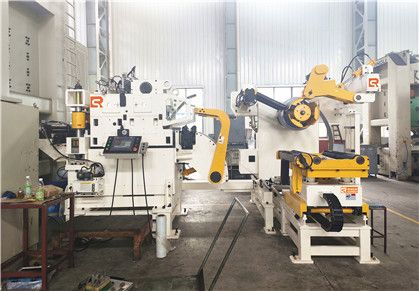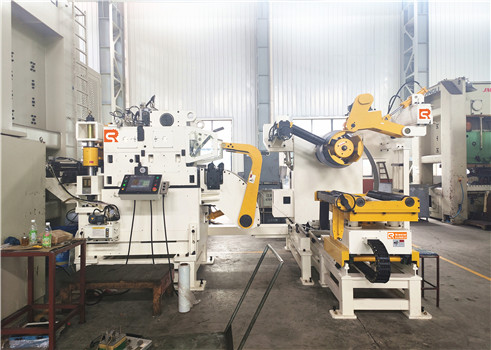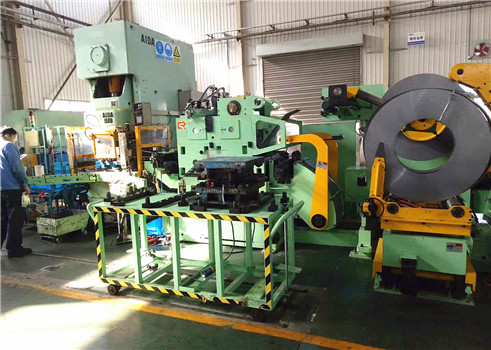6.0mm coil feeding lines for making automotive structures

Coil feed line is a type of automatic feeding equipment that is used to deliver coil material into a stamping press or other production machinery to produce various metal workpieces. The line consists of three main components: a decoiler, a straightener, and a feeder. It is ideal for high-volume stamping and forming applications in the automotive industry, as it speeds up production processes and increases efficiency.
What's The Coil Feeding Line?
A coil feed line is an automatic feeding system that delivers a coil of material into a stamping press or other production machinery to produce high-volume metal parts.. It's an essential piece of equipment for high-volume stamping and forming operations in the metalworking industry. The line consists of three main components - a decoiler, straightener, and feeder– that work together to ensure precise and efficient feeding of the material.
1. Decoiler: This is the first part of the coil feed line, responsible for unwinding the coil of material. The decoiler is usually mounted on a spindle and has a motorized or hydraulic mechanism that gradually pulls the coil's innermost end. Decoilers are available in a variety of models, including vertical and horizontal configurations, single and double mandrel designs, and pneumatic and electric brakes. The size and weight of the coil material should be considered in choosing an appropriate decoiler.
2. Straightener: The straightener's main function is to flatten and align the material for accurate feeding into the press. The straightener typically contains a set of rollers and can have different types of roller configurations depending on the application. Straighteners can be either compact or modular, depending on the available floor space and feeding accuracy required. The straightener's roller components can either be individually adjustable or hydraulically controlled to ensure uniformity across the entire material's width.
3. Feeder: The feeder's primary role is to move the straightened material from the coil and into the stamping press or other production equipment. Depending on the application, the feeder can be a part of the straightener, or it can be a separate unit altogether. It has a set of gripper arms which hold the material to ensure accuracy and consistency during feeding. The feeder's speed, accuracy, and reliability are critical in ensuring the finished product's quality and quantity.
In summary, the coil feed line is a complex and evolved system that integrates a decoiler, straightener, and feeder to ensure an efficient and accurate feeding process. The three components should be designed to work harmoniously with one another, with precise controls to guarantee consistency and quality in the output products. A well-designed and maintained coil feed line can contribute to increased productivity and profitability for any metal forming processes.


How To Build An Efficient Coil Feed Line?
To build a suitable coil feed line for making automotive structure like mounting bracket, seat belt buckle, and so on, here are some considerations: 1. Consider the size and thickness of the coil material: The coil feed line should be able to handle the specific size and thickness of the coil material required for producing automotive structures. Also, ensure that the weight and width of the coil material and the load capacity of the decoiler are compatible.
2. Choose the correct straightener design: Consider the number of rollers, roller diameter, and precision adjustment when choosing the straightener design. The straightener should have enough rollers to ensure that the coil material is delivered straight and true during the feeding process.
3. Check feeding accuracy: The coil feed line should be calibrated to ensure feeding accuracy and consistency. The feeder should be able to deliver the material at a constant speed and within an acceptable tolerance range.
4. Include safety features: Integrate safety guards, emergency stops, and a lockout system to ensure the safety of the operator. The equipment should meet the safety standards set by the Occupational Safety and Health Administration (OSHA).
5. Evaluate production speed: The coil feed line should be able to meet the production needs of the automotive structures. Check the speed and accuracy of feeding to ensure that the equipment can produce parts efficiently.
6. Choose the right supplier: Choose a reputable supplier that is familiar with automotive production needs, offers customized solutions, and provides after-sales support. The supplier should have experience in building and installing coil feed lines for the automotive industry.
7. Consider the end product: Understand the specific requirements and tolerances for producing automotive structures, such as mounting brackets and seatbelt buckles, before designing the feed line. This will ensure that the equipment and the production process can deliver high-quality parts consistently.
In conclusion, building a suitable coil feed line for producing automotive structures requires careful consideration of the specific application's needs, material size, safety, speed, accuracy, and supplier selection. The success of any production requires the right equipment and an efficient production process that adheres to industry standards and produces consistent parts.
Why Recommed SUNRUI Coil Feed Line?
SUNRUI coil feeding line with the following features:
1. Robustness and Durability: automotive structures are critical components that require high strength and reliability, it's essential to choose a coil feed line that is robust and durable. The line should be able to withstand the stresses of producing automotive parts and be constructed with high-quality materials.
2. Customizable Solutions: Your customer might have a unique application that requires customized solutions, so you should be able to provide specialized configurations meet their needs. You should be able to customize the coil feed line system to accommodate different sizes, weights, and widths of the materials being produced.
3. Safety Features: Safety is a top priority in any metalworking facility, so coil feed line should be designed with safety features such as emergency stop buttons, protective barriers, and visual and audible alarms. This ensures that operators and maintenance personnel are protected when using the equipment.
4. High-Speed Performance: The coil feed line should be designed to operate at high-speeds to meet the production requirements of the automotive industry. It should be able to deliver the material at constant speed and within an acceptable range to ensure that the production process is efficient and produces consistent parts.
5. Automation & Control:ating the coil feed line process can improve throughput and reduce errors. The line's automation can control the process of loading coils, straightening materials, and feeding them into the press, optimizing productivity and reducing waste.
6. After-Sales Support: the supplier of the coil feed line you should also provide after-sales support to ensure that the equipment is accurately installed and maintained, as well offer software updates and system upgrades to extend the equipment's life.
In summary, providing a coil feed for making automotive structures such as mounting brackets and seatbelt buckles require attention to several specific factors, especially when it comes to ensuring the reliability, safety, and efficiency of the production process. With careful consideration in these areas, you can provide your customer with a coil feed line that meets their needs and requirements. Our customer was impressed with the high-performance and reliability of our coil feed lines. The machines' robust construction and customization capabilities provided them with the flexibility needed to handle their diverse of products. The safety features and automation ensured that their operators and maintenance personnel were safe while the machinesized productivity. Our after-sales support was also appreciated, ensuring the machines operated at peak performance.
Our knowledge and experience in the metalworking industry allowed us to help our customer determine which coil feed lines would best meet their specific requirements. We were able to provide a tailored solution that increased their productivity, quality, and safety. This resulted in a successful partnership between them and us, and we look forward to supporting their future production requirements.


